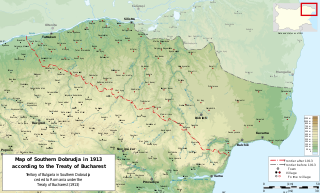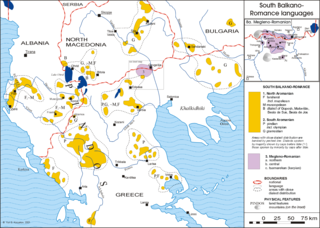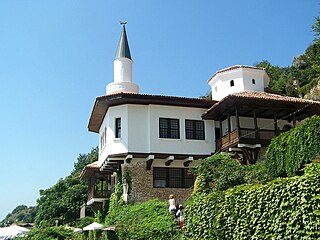
Northern Dobrogea is the part of Dobrogea within the borders of Romania. It lies between the lower Danube River and the Black Sea, bordered in the south by Southern Dobrogea, which is a part of Bulgaria.

Dobruja or Dobrudja is a historical region in the Balkans that has been divided since the 19th century between the territories of Bulgaria and Romania. It is situated between the lower Danube River and the Black Sea, and includes the Danube Delta, Romanian coast, and the northernmost part of the Bulgarian coast. The territory of Dobruja is made up of Northern Dobruja, which is a part of Romania, and Southern Dobruja, which is a part of Bulgaria.

Southern Dobruja, South Dobruja or Quadrilateral is an area of north-eastern Bulgaria comprising Dobrich and Silistra provinces, part of the historical region of Dobruja. It has an area of 7,566 km2 and a population of 358,000. It was a part of Kingdom of Romania de jure from 1913 to 1918 and again from 1919 to 1940.

The Aromanians are an ethnic group native to the southern Balkans who speak Aromanian, an Eastern Romance language. They traditionally live in central and southern Albania, south-western Bulgaria, northern and central Greece and North Macedonia, and can currently be found in central and southern Albania, south-western Bulgaria, south-western and eastern North Macedonia, northern and central Greece, southern Serbia and south-eastern Romania. An Aromanian diaspora living outside these places also exists. The Aromanians are known by several other names, such as "Vlachs" or "Macedo-Romanians".
The Megleno-Romanians, also known as Meglenites, Moglenite Vlachs or simply Vlachs, are an Eastern Romance ethnic group, originally inhabiting seven villages in the Moglena region spanning the Pella and Kilkis regional units of Central Macedonia, Greece, and one village, Huma, across the border in North Macedonia. These people live in an area of approximately 300 km2 in size. Unlike the Aromanians, the other Romance-speaking population in the same historic region, the Megleno-Romanians are traditionally sedentary agriculturalists, and not traditionally transhumants. Sometimes, the Megleno-Romanians are referred as "Macedo-Romanians" together with the Aromanians.

The Treaty of Craiova was signed on 7 September 1940 and ratified on 13 September 1940 by the Kingdom of Bulgaria and the Kingdom of Romania. Under its terms, Romania had to allow Bulgaria to retake Southern Dobruja, which Romania had gained after the 1913 Second Balkan War. Bulgaria had to pay 1 million lei as compensation for the investment provided to the region by Romania.

Megleno-Romanian is a Balkan Romance language, similar to Aromanian. It is spoken by the Megleno-Romanians in a few villages in the Moglena region that spans the border between the Greek region of Macedonia and North Macedonia. It is also spoken by emigrants from these villages and their descendants in Romania, in Turkey by a small Muslim group, and in Serbia. It is considered an endangered language.

The historical regions of Romania are located in Central, Southeastern, and Eastern Europe. Romania came into being through the unification of two principalities, Wallachia and Moldavia in 1862. The new unitary state extended over further regions at various times during the late 19th and 20th centuries, including Dobruja in 1878, and Transylvania in 1918.
About 9.3% of Romania's population is represented by minorities, and 13% unknown or undisclosed according to 2021 census. The principal minorities in Romania are Hungarians and Romani people, with a declining German population and smaller numbers of Poles in Bukovina, Serbs, Croats, Slovaks and Banat Bulgarians, Ukrainians, Greeks, Jews, Turks and Tatars, Armenians, Russians, Afro-Romanians, and others.

Ceamurlia de Jos is a commune in the southeast of Tulcea County, Northern Dobruja, Romania. It has a total population of 2,620 and it has an area of 119,43 km². The Golovița Lake is located south of this commune. Its name is derived from Turkish Çamurlu, meaning "muddy".
The Romanian dialects are the several regional varieties of the Romanian language (Daco-Romanian). The dialects are divided into two types, northern and southern, but further subdivisions are less clear, so the number of dialects varies between two and occasionally twenty. Most recent works seem to favor a number of three clear dialects, corresponding to the regions of Wallachia, Moldavia, and Banat, and an additional group of varieties covering the remainder of Transylvania, two of which are more clearly distinguished, in Crișana and Maramureș, that is, a total of five.

Caliacra County was a county (județ) of Romania in the interwar period, in Southern Dobruja, with the seat at Bazargic.

Cerna is a commune in Tulcea County, Northern Dobruja, Romania. It is composed of four villages: Cerna, General Praporgescu, Mircea Vodă, and Traian. The commune is inhabited by a large number of Megleno-Romanians.

Eugen Filotti was a Romanian diplomat, journalist and writer. As a diplomat he worked at the League of Nations in Geneva and then as minister plenipotentiary in Turkey, Greece, Bulgaria, and Hungary. As minister plenipotentiary to Budapest he issued transit visas for Jews during the Holocaust. He was secretary general of the Ministry of Foreign Affairs in 1944–1945. As writer he published several translations of literary works.

Bulgarians are a recognized minority in Romania, numbering 7,336 according to the 2011 Romanian census, down from 8,025 in 2002. Despite their low census number today, Bulgarians from different confessional and regional backgrounds have had ethnic communities in various regions of Romania, and during the Middle Ages Bulgarian culture has exerted considerable influence on its northern neighbour. According to one Bulgarian estimate, Romanian citizens of Bulgarian origin number around 250,000. According to the Romanian census of 2021, among the 5,975 ethnic Bulgarians, 3,583 were Roman Catholics, 1,977 were Romanian Orthodox and 21 were Serbian Orthodox.
Nova Cherna is a village on the Danube, in northeastern Bulgaria, part of Tutrakan Municipality, Silistra Province. The current name is derived from the commune of Cerna in Northern Dobruja, whence its Bulgarian villagers were resettled and replaced by Megleno-Romanians according to the population exchange stipulated by the Treaty of Craiova in 1940. A nature reserve named Kalimok Brashlen is located near the village.

Sabin Manuilă was an Austro-Hungarian-born Romanian statistician, demographer and physician. A nationalist activist during World War I, he became noted for his pioneering research into the biostatistics of Transylvania and Banat regions, as well as a promoter of eugenics and social interventionism. As a bio- and geopolitician, Manuilă advocated the consolidation of Greater Romania through population exchanges, colonization, state-sponsored assimilation, or discriminatory policies.

The territorial evolution of Romania includes all the changes in the country's borders from its formation to the present day. The precedents of Romania as an independent state can be traced back to the 14th century, when the principalities of Moldavia and Wallachia were founded. Wallachia during its history lost several portions of its territory, either to the Ottomans or the Habsburgs. However, this land would be later essentially recovered in its entirety. Moldavia, on the other hand, suffered great territorial losses. In 1774, the Habsburgs invaded Bukovina and annexed it one year later, and in 1812, the Russian Empire took control of Bessarabia. Both territories were later exposed to powerful colonization policies. The principalities declared unification in 1859 as the Principality of Romania. This new state sought independence from the Ottoman Empire's vassalage, and in 1878, it fought a war against it alongside Russia. However, the latter would annex Southern Bessarabia, which was recovered decades before. Romania received Northern Dobruja as compensation, and would wage a war for the southern part against Bulgaria in 1913.

Dobruja Day is a public holiday of Romania celebrated every 14 November that commemorates the incorporation of the region of Northern Dobruja into Romania on 14 November 1878.
The Aromanians in Bulgaria, commonly known as "Vlachs" and under several other names, are a non-recognized ethnic minority in the country. There are an estimated 2,000 to 3,000 Aromanians in Bulgaria, although estimates coming from Bulgarian Aromanians themselves raise this number to 6,000. They live in the Western Rhodopes, the Blagoevgrad, Pazardzhik, Plovdiv and Sofia provinces and in the city of Sofia, the capital of Bulgaria itself. More precisely, the Aromanians of Bulgaria are concentrated in the villages of Anton and Dorkovo and on the cities and towns of Blagoevgrad, Dupnitsa, Peshtera, Rakitovo, Samokov, Sofia and Velingrad, as well as on parts of the aforementioned provinces located in the Balkan Mountains. Some also live on the towns of Bratsigovo and Pirdop and on the cities of Plovdiv and Pazardjik, as well as on the Rila mountain range.
















